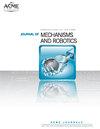半球空间尾鳍振荡模式的数值与实验研究
IF 2.2
4区 计算机科学
Q2 ENGINEERING, MECHANICAL
Journal of Mechanisms and Robotics-Transactions of the Asme
Pub Date : 2023-06-28
DOI:10.1115/1.4062862
引用次数: 0
摘要
实现巡航、潜水和转弯等多维运动是仿生机器鱼发展的一个关键挑战。当只关注尾鳍运动时,金枪鱼的尾鳍会产生显著的侧向力和推进力,而升力较弱,而相比之下,海豚的尾鳍则产生显著的升力和推进力以及较弱的侧向力。本文介绍了一种新的半球空间尾鳍振荡模式,将在金枪鱼和海豚身上观察到的尾鳍振荡特征扩展到更广泛的生物体。首先,我们提出了半球空间尾鳍振荡模式的概念,并通过理论计算证明了升力分布的原理。此外,我们还通过数值模拟详细描述了机器鱼在不同尾鳍振荡模式下的受力分布。最后,我们通过实验验证了半球空间尾鳍振荡模式的可行性。结果表明,通过改变仿生机器鱼尾鳍的振荡模式,可以将鳍运动产生的升力分配给各种力,以帮助实现多维运动,包括推进力、侧向力和升力。本文章由计算机程序翻译,如有差异,请以英文原文为准。
Numerical and Experimental Study on Caudal Fin Oscillation Mode in Hemispherical Space
Attaining multidimensional movements, such as cruising, diving, and turning, is a crucial challenge in the development of bionic robotic fish. When only focusing on caudal fin movements, the caudal fin of a tuna generates significant lateral and propulsive forces and weak lift, while in contrast, the caudal fin of a dolphin generates significant lift and propulsive forces and weak lateral forces. The paper introduces a novel caudal fin oscillation mode for the hemispherical space, which extends the caudal fin oscillation features observed in tuna and dolphin to a broader range of organisms. Firstly, we presented the concept of hemispherical space caudal fin oscillation mode, and demonstrated the principle of lift distribution through theoretical calculations. Moreover, we detailed the force distribution obtained by the robotic fish under different caudal fin oscillation modes through numerical simulations. Finally, we experimentally validated the feasibility of the hemispherical space caudal fin oscillation mode. The results indicate that by modifying the oscillation mode of the caudal fin in bionic robotic fish, it is possible to distribute the lift generated by the fin movement to various forces that aid in achieving multidimensional movement, including propulsive, lateral, and lift forces.
求助全文
通过发布文献求助,成功后即可免费获取论文全文。
去求助
来源期刊

Journal of Mechanisms and Robotics-Transactions of the Asme
ENGINEERING, MECHANICAL-ROBOTICS
CiteScore
5.60
自引率
15.40%
发文量
131
审稿时长
4.5 months
期刊介绍:
Fundamental theory, algorithms, design, manufacture, and experimental validation for mechanisms and robots; Theoretical and applied kinematics; Mechanism synthesis and design; Analysis and design of robot manipulators, hands and legs, soft robotics, compliant mechanisms, origami and folded robots, printed robots, and haptic devices; Novel fabrication; Actuation and control techniques for mechanisms and robotics; Bio-inspired approaches to mechanism and robot design; Mechanics and design of micro- and nano-scale devices.
 求助内容:
求助内容: 应助结果提醒方式:
应助结果提醒方式:


